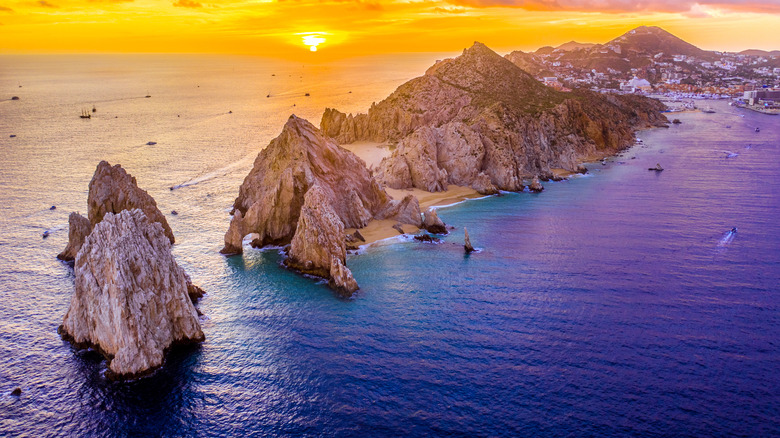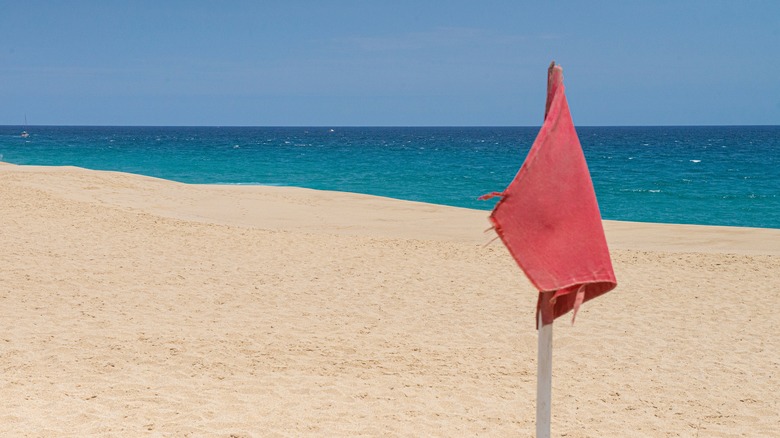Tourists Have A Deadly Warning About One Of Mexico's Most Popular Beach Vacation Spots
Located in Baja California, Los Cabos is a relaxing Mexican beach vacation destination. The fun-filled paradise is renowned for its natural beauty, apparent in its spectacular beaches, turquoise waters, and the iconic Arch of Cabo San Lucas. With gorgeous resorts and endless opportunities for adventure, it's no wonder that millions of tourists visit each year. However, many of this travel hot spots' beaches are considered dangerous for unsettling reasons: Strong rip tides and massive waves.
In fact, conditions have sometimes been so severe that government officials warned the public to keep out of the ocean. Several videos online show how colossal the waves in Cabo can get. They loom high above before dramatically breaking and sweeping onto the shore, which can take tourists by surprise. Likewise, Cabo is known to have rogue or freak waves, and oceanographer Libe Washburn told National Geographic that rogue waves have been known to reach 100 feet.
One reviewer on Tripadvisor who goes by the username "shotgunbullet," wrote about witnessing his son's encounter with a rogue wave in Cabo, saying, "The wave rose up well above his head and came crashing down on him, the powerful current scraping him off of the beach into the sea. One second he was there, the next second all I could see was an explosion of white foam and a wave that came to the highest point on the beach." The reviewer's son and the rest of his family survived the incident unscathed, but others haven't been as lucky.
Rogue waves have taken lives in Los Cabos
As "shotgunbullet" described, he and his family were unaware of the dangers held by Los Cabos' beaches. He said, "This is the best warning you are going to get. No one in Cabo is going to tell you about the rogue waves or the scores of people who have faced tragedy." With that said, in June 2016, a couple in their 80s, Richard and Nancy Culpepper, were in Cabo when a rogue wave pulled them into the water, killing them.
The Culpeppers, who had been walking on the beach when the incident occurred, were celebrating their 66th anniversary. Shortly after, in August 2016, another couple, Lisa Kaminski and Maggie Gutierrez were vacationing in Cabo when they fell victim to a rogue wave while hiking. Kaminski survived, but Gutierrez did not. In October 2017, twin sisters Beverly Ann Skripsky and Barbara Jo Thomas were killed by a rogue wave in Cabo during a walk on the beach.
Speaking to NBC Chicago, Barbara's husband, Steve Thomas, explained, "I can't imagine how fast it was moving, but it went from 10 feet to 15 feet in seconds." He added, "They found two women out at sea and I'm thinking, 'Great — they found them,' and I say, 'Are they OK?' and he says, 'I'm sorry to tell you sir, but they're deceased.'" The outlet states that another individual had died from a rogue wave in Cabo only a week prior to the twin's death.
Pay attention to the signs and flags on Cabos' beaches
Rogue waves are unpredictable and mysterious to scientists. If you plan to visit Los Cabos' beaches, keep your eyes on the ocean. If there's a large or rogue wave, you'll be able to see it coming and can move away from the shore. Unsurprisingly, not all of Los Cabos' beaches are recommended for beachgoers due to safety concerns regarding surf conditions. For example, swimming is prohibited at Pedregal Beach, Playa Solmar, and Divorce Beach. Note that the incident described by Tripadvisor reviewer "shotgunbullet," happened at Divorce Beach.
Visitors to Los Cabos will be met with signs at the beaches warning them of danger and notifying them if swimming or other water-based activities are banned. Los Cabos also has a beach flag program to alert beachgoers to surf conditions. These flags come in six colors: Green, yellow, red, blue, and white. A green flag denotes that there's little risk of going into the water, while a yellow flag signals that there is some danger.
A red flag at the beach means that swimming is prohibited. If the flag is black, the beach is closed. If the flag is white, marine life is in the water. A blue flag at the beach means that it's certified by the Foundation for Environmental Education. These beaches are considered exceptionally uncontaminated and typically have more significant safeguards (like lifeguards) than other beaches in Cabo. This includes Medano Beach, Playa Acapulquito, Chileno Beach, and more.


